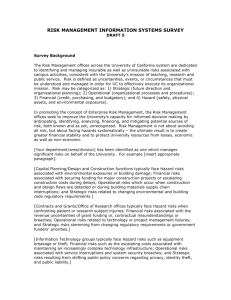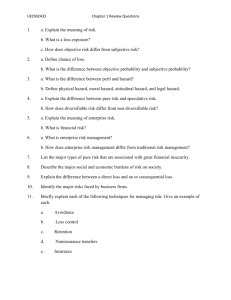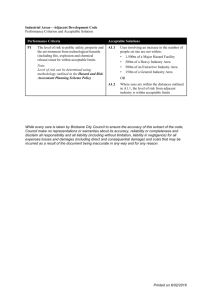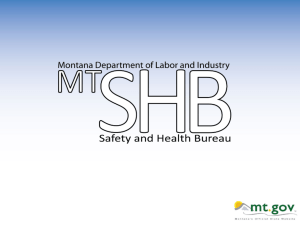risk management information systems survey
advertisement
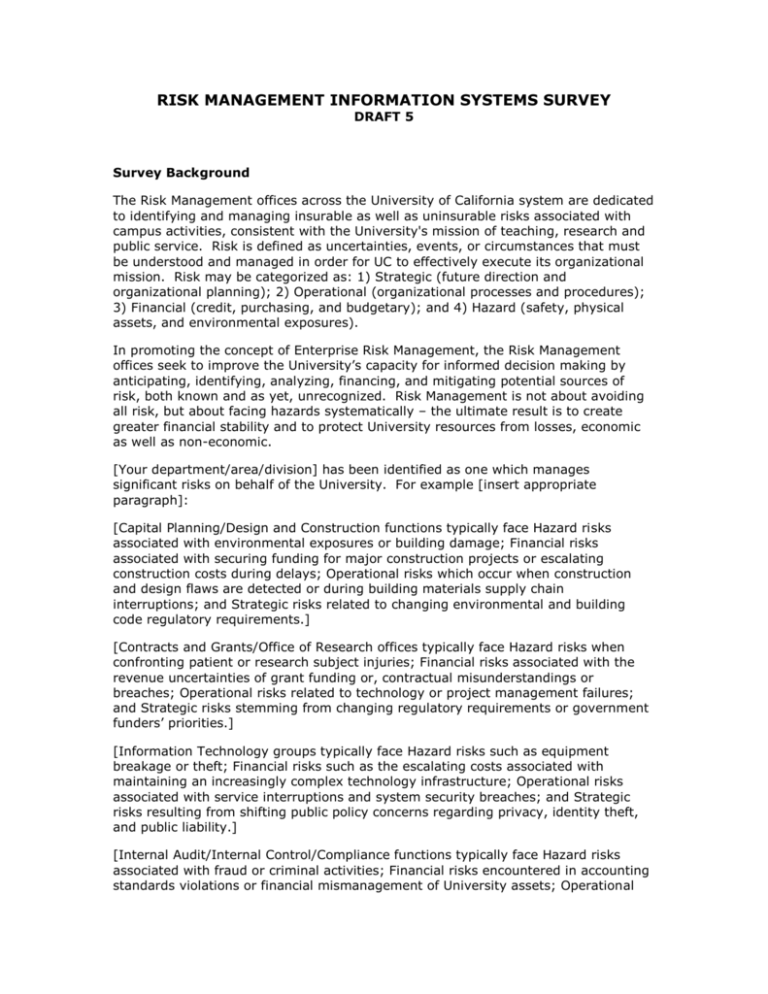
RISK MANAGEMENT INFORMATION SYSTEMS SURVEY DRAFT 5 Survey Background The Risk Management offices across the University of California system are dedicated to identifying and managing insurable as well as uninsurable risks associated with campus activities, consistent with the University's mission of teaching, research and public service. Risk is defined as uncertainties, events, or circumstances that must be understood and managed in order for UC to effectively execute its organizational mission. Risk may be categorized as: 1) Strategic (future direction and organizational planning); 2) Operational (organizational processes and procedures); 3) Financial (credit, purchasing, and budgetary); and 4) Hazard (safety, physical assets, and environmental exposures). In promoting the concept of Enterprise Risk Management, the Risk Management offices seek to improve the University’s capacity for informed decision making by anticipating, identifying, analyzing, financing, and mitigating potential sources of risk, both known and as yet, unrecognized. Risk Management is not about avoiding all risk, but about facing hazards systematically – the ultimate result is to create greater financial stability and to protect University resources from losses, economic as well as non-economic. [Your department/area/division] has been identified as one which manages significant risks on behalf of the University. For example [insert appropriate paragraph]: [Capital Planning/Design and Construction functions typically face Hazard risks associated with environmental exposures or building damage; Financial risks associated with securing funding for major construction projects or escalating construction costs during delays; Operational risks which occur when construction and design flaws are detected or during building materials supply chain interruptions; and Strategic risks related to changing environmental and building code regulatory requirements.] [Contracts and Grants/Office of Research offices typically face Hazard risks when confronting patient or research subject injuries; Financial risks associated with the revenue uncertainties of grant funding or, contractual misunderstandings or breaches; Operational risks related to technology or project management failures; and Strategic risks stemming from changing regulatory requirements or government funders’ priorities.] [Information Technology groups typically face Hazard risks such as equipment breakage or theft; Financial risks such as the escalating costs associated with maintaining an increasingly complex technology infrastructure; Operational risks associated with service interruptions and system security breaches; and Strategic risks resulting from shifting public policy concerns regarding privacy, identity theft, and public liability.] [Internal Audit/Internal Control/Compliance functions typically face Hazard risks associated with fraud or criminal activities; Financial risks encountered in accounting standards violations or financial mismanagement of University assets; Operational risks associated unethical conduct or policy non-compliance, and Strategic risks related to changing Federal regulations and legislation.] [Medical Center Administration faces considerable Hazard risk associated with patient safety concerns; Financial risks associated with the rapidly escalating cost of delivering health care and the increasing demand for uncompensated care; Operational risks such as labor shortages and credentialing pressures; and Strategic risks concerning Medicare reimbursement politics and public pressure for health system reform.] [Student Affairs offices face Hazard risks associated with student injuries and safety violations; Financial risks resulting from liability for fulfillment of educational contracts; Operational risks related to aging instructor retirements and toughened credentialing requirements; and Strategic risks associated with increasing private university competition and shifting laws regarding student diversity.] The Risk Management offices currently utilize an information system which contains data regarding Hazard risks associated with insured and self-insured property loss, automobile damage, and liability claims. This database (known as the Valley Oak System or VOS) records only information relevant to the management of individual claims of damage or liability. Risk Management seeks to access relevant information regarding other current and potential sources of risk or loss so as to better accomplish its mission of anticipating and identifying (as yet unrecognized) risks that can have a tangible impact on the UC enterprise. Survey UC Office of the President, Office of Risk Services has endorsed a group of UC risk management professionals to survey campus entities like yours regarding existing information systems utilization to determine what the vulnerabilities and threats you are aware of and how you track and manage them. In order to facilitate the analysis of enterprise-wide sources of risk, we ask that you please respond the following questions: 1) From your perspective, what are the 5 most important risks facing the University? Risk How is it measured? 2) What University-wide database(s) (i.e. information system developed and supported by the UC Office of the President and available to all campus locations) do you utilize to track/report on these risks? Name of System (OLPPS, OLFS, etc.) Data accessed/stored/analyzed using this system (describe primary data elements) 3) What campus-based systems (“homegrown” or “moonshine” systems) do you utilize in addition to or in combination with systems noted above to track/report on these risks? Name of System Brief description of system’s function Data accessed/stored/analyzed using this system (list primary data elements used by this homegrown system) 4) From your perspective, over the next five years, what will be the 3 biggest unrecognized risks? Risk How it affects your area 5) What additional information regarding potential sources of loss, risk analysis, and/or risk reduction would help you accomplish your area’s goals and objectives? Thank you for your assistance and interest. The Risk Management group will provide you with a summary of the results of this survey within __ weeks. In the meantime, if you have additional questions or comments, please contact _________.
